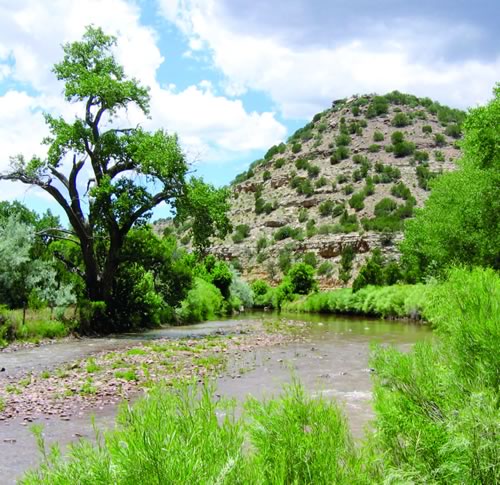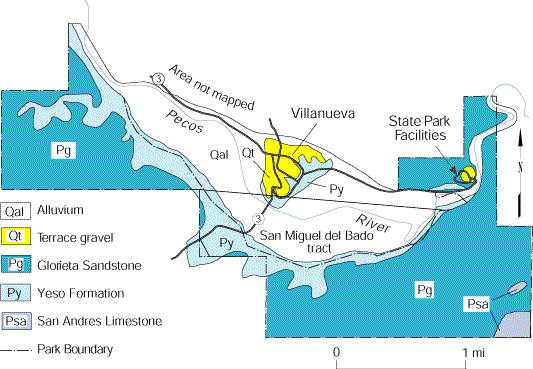
Villanueva State Park
modified from McLemore, V.T., 1996, Villanueva State Park: New Mexico Geology, v. 18, p. 38-41.
Introduction

Villanueva State Park is south of the small village of Villanueva on NM–3, approximately 23 miles southwest of Las Vegas (Fig. 1). Villanueva means new town in Spanish, but this town was already an old community when it received its name in 1890 (Pearce, 1965; Stanley, 1970; Young, 1984; Julian, 1996). The village name was derived from the name of one of the prominent families of the time, the Villanuevas (Stanley, 1970; Foster, 1984). Local families petitioned the U.S. government for a U.S. Post Office, and it is said that the petition contained more signatures from the Villanueva family; thus the town received its name in 1890. It was originally called La Cuesta (Spanish, “hill”) because the village sits on top of a steeply sloping hill or cuesta in the Pecos Valley.

Geoffrey Rawling
Access to the park can be reached from the south via paved roads from an exit on I–40, approximately 70 miles east of Albuquerque to NM–3 or from the north via an exit on I–25, approximately 43 miles east of Santa Fe to NM–3 (Fig. 1). The south route from I–25 takes the traveler over rolling hills and mesas to the top of Glorieta Mesa, which forms the edge of the Pecos Valley. The north route from I–25 takes the traveler along the Pecos River (Fig. 2) and passes through the small Spanish communities of Ribera, San Miguel, Pueblo, and Sena. Neither route is intended for high-speed traffic, so plan to take your time and enjoy the scenery. Once in Villanueva, look for the signs leading to the state park.
Geology

Rocks exposed in the park are Recent, Late Pleistocene, and Permian in age (Fig. 3). The oldest rocks form the lower parts of the towering 300–500 ft high cliffs of Glorieta Mesa and were deposited during the middle to late Permian, about 268–245 million years ago. The oldest rocks, belonging to the Permian Yeso Formation, form the lower slopes below the cliffs and consist of alternating beds of red to orange, calcareous siltstone and fine- to medium-grained, calcareous quartz sandstone with local beds of dolomitic limestone up to 15 ft thick. The Yeso Formation is less than 150 ft thick at the park. The unit was deposited in coastal sabkha and eolian environments (Stanesco, 1991). The Yeso Formation overlies the older Lower Permian Sangre de Cristo Formation (exposed to the north near I–25) and is overlain by the younger Glorieta Sandstone. The upper contact of the Yeso Formation is gradational from the red to orange siltstones and sandstones to the overlying cleaner, gray Glorieta Sandstone.
Glorieta Mesa and the uppermost part of the cliffs are formed by the Glorieta Sandstone and capped by the San Andres Formation (Johnson, 1970; Anderson et al., 1995). Most of the 300–500-ft-high cliffs visible in the park are formed by the Glorieta Sandstone, which is 150 to 350 ft thick and consists of white to light-gray to brown, massive to thin-bedded, fine- to medium-grained quartz sandstone with thin interbeds of yellow to red to gray siltstone (Griggs and Hendrickson, 1951). The sandstones are typically crossbedded, indicating deposition in eolian dunes and local streams along the shoreface of the Permian sea, which extended across New Mexico at this time. Some units of the Glorieta Sandstone consist of very pure quartz, suggesting deposition by sand dunes. The Glorieta Sandstone intertongues with both the underlying Yeso Formation and overlying San Andres Formation.
The San Andres Formation, the youngest of the Permian rocks, crops out locally, out of view of the valley on top of Glorieta Mesa. There, the San Andres Formation is thin, only 9–20 ft thick, and consists of gray to brown fine-grained limestone with local silty interbeds. It was deposited in marine environments of the Permian sea. Both the Glorieta Sandstone and San Andres Formation are exposed along the south route from I–40.
The Pecos River runs through the state park; the main facilities are situated at the bottom of the steep cliffs of Glorieta Mesa. Downcutting by the Pecos River during the last million years formed this picturesque valley. Villanueva and Villanueva State Park occur at natural bends in the meandering Pecos River. Upstream of Villanueva, the Pecos River flows along a broad river valley, whereas downstream of the picnic area the river incises a steep, meandering, narrow gorge. The valley floor consists of Quaternary alluvium, less than 15,000 years old, of unconsolidated gravel, sand, silt, and clay derived from eroding the nearby cliffs and subsequently deposited by the river. Pebbles of Precambrian rocks (granite, gneiss, schist) and older limestone and sandstone eroded from areas upstream, are found in the river bed. Much of the farmland is also on this alluvium. The fine-grained alluvium found in these deposits is used to make the adobe houses.
The town of Villanueva and El Cuervo picnic area in the state park rest on older alluvial stream-terrace deposits of gravel, sand, and silt. Locally, these deposits are as thick as 100 ft and are older than the floodplain deposits forming the river bottom. Current mapping by University of New Mexico students suggests that there are several levels of stream terraces along the river and they may be related to melting of glaciers at the headwaters of the Pecos River, mainly Truchas Peaks, during the Wisconsin, approximately 115,000–10,000 years ago.
Villanueva sits on a cuesta (Fig. 4) that dips steeply to the northeast and is approximately 100 ft above the river. This cuesta is capped by terrace deposits of gravel, sand, and silt that overlie steeply dipping sandstone beds of the Yeso Formation, which are poorly exposed on the slopes southeast of the village (Fig. 3). Part of the upper El Cuervo picnic area in the state park also lies on remnant stream-terrace deposits, approximately 75 ft above the river.

References
- Anderson, O. J., Lucas, S. G., Kottlowski, F. E., Bauer, P. W., Love, D. W., Hawley, J. W., Smith, G. S., Pazzaglia, F. J., and Cross, A., 1995, Stratigraphic nomenclature chart; in Bauer, P. W., Kues, B. S., Dunbar, N. W., Karlstrom, K. E., and Harrison, B., Geology of the Santa Fe region, New Mexico: New Mexico Geological Society, Guidebook 46, back cover.
- Foster, R., 1984, Villanueva: New Mexico Geology, v. 6, no. 2, pp. 26–27.
- Griggs, R. L., and Hendrickson, G. E., 1951, Geology and groundwater resources of San Miguel County, New Mexico: New Mexico Bureau of Mines and Mineral Resources, Groundwater Report 2, 121 pp.
- Johnson, R. B., 1970, Geologic map of the Villanueva quadrangle, San Miguel, New Mexico: U.S. Geological Survey, Geological Quadrangle Map GQ–869, scale 1:24,000.
- Julyan, R., 1996, The place names of New Mexico: University of New Mexico Press, Albuquerque, 385 pp.
- Pearce, T. M., 1965, New Mexico place names: a geographical dictionary: University of New Mexico Press, Albuquerque, 187 pp.
- Stanesco, J. D., 1991, Sedimentology and depositional environments of the Lower Permian Yeso Formation, northwestern New Mexico: U. S. Geological Survey, Bulletin 1808, pp. M1–M15.
- Stanley, F., 1970, The Villanueva, New Mexico story: F. Stanley, P.O. Box 107, Nazareth, Texas, 24 pp.
- Young, J. V., 1984, The state parks of New Mexico: University of New Mexico Press, Albuquerque, 160 pp.



